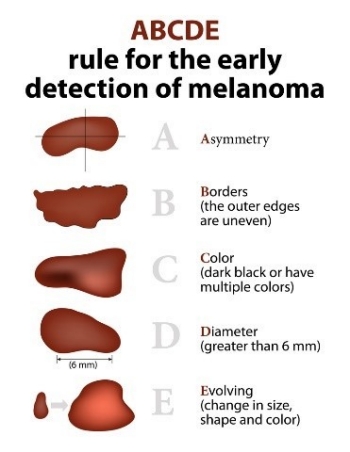The UCSF-John Muir Health Jean and Ken Hofmann Cancer Center at the Behring Pavilion is now open. LEARN MORE >
What is Cutaneous Melanoma?
Cutaneous melanoma is a type of skin cancer most commonly associated with ultraviolet (UV) radiation due to sun exposure and tanning beds. It is usually pigmented (like a dark freckle) but can also have no color at all. Cutaneous melanoma occurs on the surface of the skin, most often arising from a pre-existing birth mark or mole that has changed over time. However, it can also occur as a new growth. Cutaneous melanoma is most commonly found on the back in men and on the legs in women.
What is Mucosal Melanoma?
Mucosal melanoma is a type of head and neck cancer that begins in the mucous membranes of the mouth, nose, throat or voice box. It often spreads easily due to the presence of many blood vessels and lymph nodes in the head and the neck.
What are the Risk Factors for Melanoma?
Melanoma is caused by a combination of environmental and heredity factors, including:
- History of intense sunburns, especially at a young age
- Tanning bed exposure
- Blue/green eyes, blond/red hair, light complexion, freckles, numerous moles
- Weakened immune system, from a medical condition and / or medications
- Family history of melanoma, ie two first-degree relatives or three relatives
- Hereditary syndromes (10%), such as xeroderma pigmentosum
- Most common in Caucasians (1 in 50); least common in African Americans (1 in 1,000)

What are the ABCDEs of Melanoma?
The ABCDEs of melanoma is a guide to help recognize the signs of melanoma:
Asymmetry: Melanoma lesions are often irregular in shape. Benign (non-cancerous) moles are usually symmetrical
Border: Benign moles usually have smooth and even borders. Melanoma lesions usually have irregular borders that are difficult to define
Color: Benign moles usually have a single shade of color. The presence of more than one color (blue, black, brown, etc.) or the uneven distribution of color may be a concerning sign
Diameter: Melanoma lesions are often greater than 6 millimeters in diameter
Evolution: The evolution of a mole is one of the most important factors to consider when it comes to diagnosing melanoma